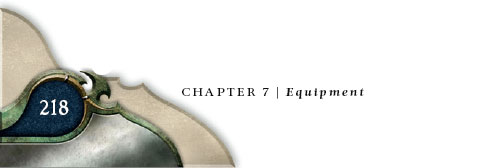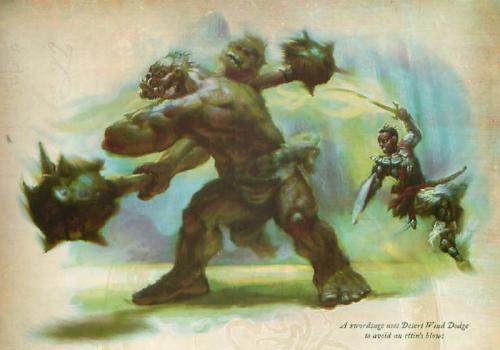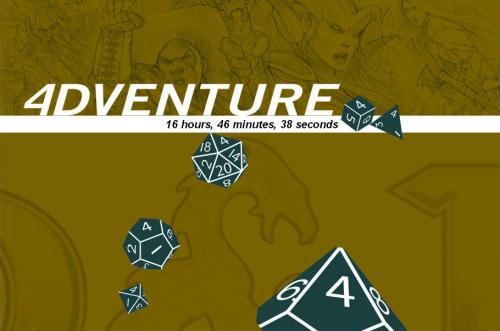From time to time a truly remarkable phrase is uttered at a D&D game. There are many variations of it, but it all boils down to “That’s not realistic!” This is ridiculous, of course. You’re playing a game with wizards and elves and dragons and such; you went through the looking glass when you picked up your dice. I ran into the following list online that demonstrates within the 3rd edition rules why anything happening past 9th level has no business even being compared to reality:
- 9th level Bard. He has 12 ranks of Perform, started with 16 Cha and increased it twice to 18 (+4). He also has a masterwork instrument (+2) and a Circlet of Persuasion (+3). His Perform modifier is now 12+4+2+3=+21. This means that, by taking ten, he nails a 31 every time. According to the PHB, this means that by playing on street corners, he will eventually attract the attention of extraplanar beings. Gimble will be sitting around drinking and playing his lute when a genie bamfs in and asks the gnome to perform at his kid’s Bar Mitzvah.
- 9th level Rogue. He has 12 ranks of Balance, started with 16 Dex and boosted it twice to 18 (+4). He gets a +2 synergy bonus from Tumble ranks, for a total modifier of 12+4+2=+18. Taking 10, he will, every time, be able to move at full speed across a one inch wide marble-covered beam. (18+10-5=23 for the check, 20+2(scree) =22 for the DC.)
- 9th level Barbarian. 12 ranks of Climb, now has 18 (+4) Strength, for a final modifier of 12+4=+16. Taking 10, he gets a 26. He can now climb most mountains while raining, moving 40 feet every 6 seconds. (Check is 26-5=21 for accelerated climbing, DC is 15+5=20 for climbing a rough natural rock surface that’s slippery.)
- 9th level Swashbuckler. 12 ranks of Jump, 12 (+1) Strength, +2 synergy from Tumble. His modifier is 12+1+2=+15. Taking 10 gets him a 25. The female world record for the long jump is (7.52 meters)*(3.28 feet/meter) = 24.7 feet. This character beats that every time he wants to. The men’s record is 8.95*3.28= 29.3 feet, which his character could swing pretty easily if he so desired. When the character rolls instead of taking 10, he can hit as much as 35 feet, blowing past the world record by two yards.
- 9th level Beguiler. 12 ranks in Disguise, 14 (+2) Charisma, with a disguise kit (+2). Total modifier is +16, taking 10 gets him a 26. He can disguise himself as a woman’s human husband (+10 for intimate familiarity) as long as she has a Spot modifier of 6 or less.
- 9th level Monk. 12 ranks in sense motive, 16 (+3) Wisdom. Final modifier is 12+3=+15. Taking 10, he can instantly tell whether a person is under the effects of Charm Person or not, every time. (DC 25) And that isn’t “I’ve a sneaking suspicion that something is wrong here” so much as it’s “Hi, my name is Benedict Thelonious. Also, you’re charmed.”
- 9th level Bard again. 12 “ranks” in Speak Language nets him 12 languages, because Bards are awesome like that. There are only 20 of the things listed in the PHB, one of them is Druidic, and he starts with a few because of race and intelligence. He learns this from hanging out in bars, and in addition to everything else he can do. I don’t think there are many people in the world that can boast that kind of repertoire, and finding one in his mid-20s that’s also a competent in battle, magic (which we can approximate to some degree with science or technology), and whatever this guy is burning his other 5+Int skill points on is fairly definitely impossible.
- 9th level Ranger goes tracking. 12 ranks in Survival, 14 (+2) Wisdom, +4 from Search and Know: Nature synergy, and +2 from some manner of tracking kit. Modifier is 12+2+4+2= +20, which means he takes 10 to get a 30. To match this, the DC is going to look like this: 4+5+1+20. That comes from tracking a single Toad (+4 DC for being Diminutive) that is covering his tracks (+5) after an hour of rainfall (+1) over bare rock (20).
Hat tip to Zilvar for pointing it out, and of course the original source by Merlin the Tuna





![[Prestige Classes]](/jdf/images/dnd_spellbook_64.gif)
![[Old-fashioned Arse-whuppin]](/jdf/images/bruce_lee_64.png) Ok, so Fighters in D&D have traditionally been pretty lousy at a wide variety of things, excelling only in pumelling, piercing, or hacking opponents into pulp. The d20 system did a lot to make the Fighter a more appealing character class, largely through the customization allowed by the class’s feat progression. This allows them to closely match the archery or two-weaponed fighting skills of a Ranger, the mounted combat skills of a Cavalier, the brutal attacking power of the Barbarian, or any suitable blend of the above. Alas, the d20 core rules don’t give them a viable means of beating the living snot out of their opponents with their bare hands.
Ok, so Fighters in D&D have traditionally been pretty lousy at a wide variety of things, excelling only in pumelling, piercing, or hacking opponents into pulp. The d20 system did a lot to make the Fighter a more appealing character class, largely through the customization allowed by the class’s feat progression. This allows them to closely match the archery or two-weaponed fighting skills of a Ranger, the mounted combat skills of a Cavalier, the brutal attacking power of the Barbarian, or any suitable blend of the above. Alas, the d20 core rules don’t give them a viable means of beating the living snot out of their opponents with their bare hands.![[Stereotypes, anyone?]](/jdf/images/dwarf_fighter_64.png)